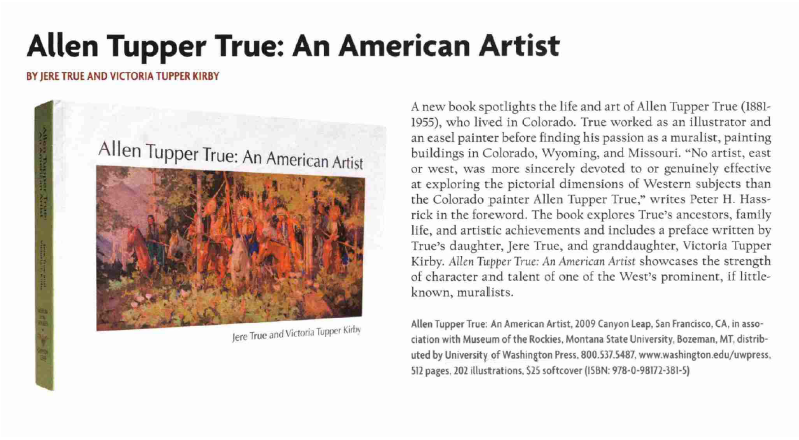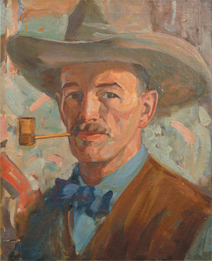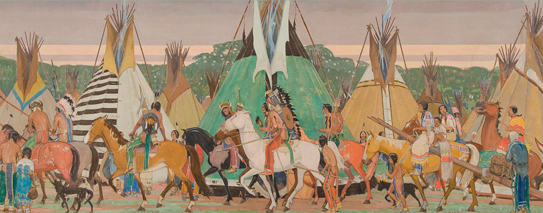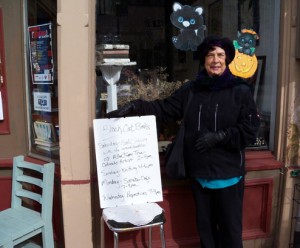Allen True’s West opened on November 12, 2010, and will run through January 9, 2011, in the El Pomar Gallery of the Colorado Springs Fine Arts Center Museum, 30 West Dale Street in Colorado Springs, CO. A well-attended opening reception was held on November 11 from 5-7 pm, followed by an illustrated talk and book signing from 7-8 pm by True’s granddaughter Victoria Tupper Kirby, co-author with her mother Jere True of the biography Allen Tupper True: An American Artist.
Allen True’s West is a touring exhibition organized by the Denver Art Museum consisting of 42 works ranging from original oil paintings and mural studies to periodical reproductions. The Fine Arts Center has supplemented its exhibition with three additional easel works borrowed from local collectors.
Allen True’s West is sponsored by El Pomar Foundation, UMB Bank Colorado Springs, KKTV and The Gazette.
Victoria Tupper Kirby was invited by Black Cat Books in Manitou Springs (about 15 minutes from Colorado Springs, CO), to sign copies of her grandfather’s biography on Saturday, November 13, from 2-4 pm. Kirby, coauthor with her mother Jere True of Allen Tupper True: An American Artist, was in the area for the opening of the touring exhibition of her grandfather’s art work Allen True’s West at the Colorado Springs Fine Arts Center Museum.
Saturday was a cold day, but Victoria and her sister Joan True McKibben (True’s other granddaughter) enjoyed exploring Manitou Springs, a delightful tourist destination with a beautiful old hotel, art galleries and speciality shops. Rachel Johnson, owner of the locally beloved bookstore, was a gracious and entertaining host.
Victoria Kirby will give an illustrated talk about the life and work of her grandfather Allen Tupper True at the Colorado Springs Fine Arts Center, 30 West Dale Street in Colorado Springs, on Thursday, November 11, 2010, at 7 pm as part of the opening events of Allen True’s West, a touring exhibition of forty-two works, including a selection of his illustrations, easel paintings and mural studies.
Kirby will also sign copies of Allen Tupper True: An American Artist, a biography co-written with her mother Jere True, at Black Cat Books, 720 Manitou Avenue in nearby Manitou Springs (about 12 minutes from the Colorado Springs Fine Arts Center) on Saturday, November 13 from 2 to 4 pm.
KBDI-PBS, Denver’s television station that produced the documentary Allen True’s West, has officially changed its name to CPT12 – Colorado Public Television. The station has also changed the link to view the hour-long video Allen True’s West. It is now:
http://video.cpt12.org/video/1393935081
If the video does not immediately appear, click in the black area and the video will begin playing.
The Children’s Hospital of Denver is having Allen True’s delightful Indian Women on Bank of Stream and Indian Women at Rest restored by the Western Center for the Conservation of Fine Art. When restoration is completed, the two murals will again be displayed at the Hospital.
The Children’s Hospital also is exploring ways to fully restore Indian Woman with Deer, which was damaged when it was removed from the wall by a workman rather than conservation experts.
On Thursday, July 8, 2010, at 6 pm, the Nicolaysen Art Museum, 400 E. Collins Drive in Casper, WY, will co-present with Hilltop National Bank “The Conservation and Restoration of Allen True’s Murals,” a lecture by Carmen F. Bria, Jr., Director and Chief Conservator at the Western Center for the Conservation of Fine Arts in Denver, CO. Mr. Bria has worked on over thirty murals by Allen Tupper True during the past twenty years, including his murals in Denver at the former Mountain States Telephone and Telegraph Building (now owned by Quest); two murals in the Greek Theatre and two in the Voorhies Memorial at Civic Center; several murals in Graland Country Day School; and the ten murals in the Colorado State Capitol; as well as the Mother Goose nursery murals in the historic Day Nursery of the Colorado Springs Child Nursery Centers in Colorado Springs.
The lecture is free and open to the public. A cash bar and appetizers will be available. For more information, call the Museum at 307-235-5247 or check its website at www.thenic.org.
Tom Noel, professor of history at the University of Colorado Denver reviewed Allen Tupper True: An American Artist for the Center for Colorado & the West’s website. Below is his review:
Center for Colorado & the West at Auraria Library
Published on coloradowest.auraria.edu (http://coloradowest.auraria.edu)
Allen Tupper True: An American Artist
| Author : Jere True and Victoria Tupper Kirby
Bozeman, MT: Museum of the Rockies, 2009. xx + 492 pages. Illustrations, endnotes, Index, 9-1/2” x 6-1/2”. $25.00 paperback. $50.00 hardcover. Reviewed By: Tom Noel University of Colorado Denver |
Artists, historians, and the general public should find this first extensive biography of Colorado’s master muralist, Allen Tupper True (1881–1955), valuable. True’s works adorn various public places including the Colorado, Missouri, and Wyoming state capitols and public libraries, the Brown Palace, Colorado National Bank, and Civic Center Park in Denver, making him easily the most seen Colorado artist of all time.
True’s works and private life are explored in this intimate portrait begun by his eldest daughter, Jere True, and completed by her daughter, Victoria Tupper Kirby. Jere began collecting material and started writing the biography in the early 1990s in hopes of protecting her father’s extant murals. By then, several had already been destroyed when the buildings they were in were demolished, or the walls, which served as their canvases, were painted over. She hoped that the publication of a biography about her father would raise awareness of his significance and works, thus encouraging preservation of his remaining murals. When Jere died in 1999, Victoria took over her mother’s project.
Based primarily on his diary, True family correspondence, and newspaper accounts, this book focuses on Allen’s personal life, including his childhood, first drawings (in letters to his parents), marriage, divorce, and children. True was born in Colorado Springs. His schoolteacher mother and well-connected father both nurtured his early desire to be an artist. After the family moved to Denver, he graduated from Corona (now Dora Moore) Elementary School and Manual High School before spending two years at the University of Denver. He then went to the Corcoran School of Art in Washington, D.C., before working with a leading illustrator, Howard Pyle, at Pyle’s School in Wilmington, Delaware. There he emerged as a promising illustrator whose work illustrated leading magazines of the day, such as Century, Colliers, Everybody’s, Harper’s, Leslie’s, McClure’s, Outing, and the Saturday Evening Post. Growing fame led to True’s first one-man show in Denver in 1908. Two years later the Denver Public Library staged another early exhibit introducing the city to its best-known twentieth-century artist. Thanks to his design of the bronco buster still seen on Wyoming license plates, as well as other work in the Cowboy State, he is also a highly visible Wyoming artist.
Having worked as illustrator, then as an easel artist, True subsequently shifted to murals after studying with one of the world’s leading muralists, Frank Brangwyn, at his London School of Art. Brangwyn enlisted True, whom he called his best student, to help him paint and install murals for San Francisco’s 1915 Panama Pacific Exposition.
Allen True was no starving artist. His father, a onetime Leadville grocer, became an official with Standard Oil, then with the American Smelting and Refining Company. He helped arrange exhibits and commissions for his son, as did prominent family friends such as Anne Evans, Henry W. Toll, and Claude Boettcher. Evans, the great Denver patroness of the arts, paid True five hundred dollars for the first work he sold, “Free Trappers,” which still hangs in her restored mountain cabin.
True rejected traditional, classical design to champion Native American and Colorado pioneer types, as well as native flora and fauna. In 1913 he told Denver Times reporter Polly Pry he favored western U.S. themes with “romance enough” for “a million miles of canvas,” rather than “fat little cupids disporting themselves amidst trailing grape vines loaded with purple fruit, and nude girls with plenteous curves reclining on clouds” (133). Although best known for Native American and Euro-American pioneer subject matter, True portrayed modern telephone workers in his Communications series for the Mountain States Telephone Building (Denver), whimsical Mother Goose figures for the Colorado Springs Child Day Care Center, and underwater sea life for the tub therapy room at Colorado Psychiatric Hospital (Denver).
No artist better captured Colorado’s pioneer era, which he studied carefully. True spent much of his life exploring Colorado’s outdoors as an avid hunter, fisherman, and camper. He visited numerous Indian tribes to familiarize himself with their lives, customs, art, and clothing. Besides firsthand study and experience, he also immersed himself in studying his subjects in books and museums.
Artistically, True borrowed from both impressionism and realism. The subtlety of color and feeling in his murals is perhaps a reaction to his magazine illustrating days with their exaggerated color and figures. “Art is nature made rhythmical,” was his motto, and he squeezed natural settings into whatever spaces he was given, exquisitely relating to the surrounding architecture. In Denver’s efforts to become a city beautiful, True played a prominent role by incorporating public art in prominent buildings. True portrayed ordinary, prototypical people, not the rich and famous. Although romanticized, his figures feel like living, vital people.
True’s masterwork, according to the authors, is his “Indian Memories,” a series of sixteen murals done in 1925 to decorate the lobby of the Colorado National Bank (a neoclassical Greek temple sold in 2009 to developers who claim they will respect the murals when they convert the bank into a hotel).
As “Indian Memories” illustrates, True strived to elevate Native American art and life. “Greeks gave us the conventional border which have been used by decorators for 2,000 years,” True declared, “and yet here in the West I have seen Navajo Indians making designs far more beautiful, in colors that were a joy to the spirit” (133). True used Native American color and designs in his largest work—selecting color schemes and designs for the powerhouse and public places at Boulder (now Hoover) Dam as the consulting artist. “Why go on forever with Greek, Roman and Egyptian motifs when our own native sources are right along side the Boulder Dam,” he asked and used “stepped mesas, rain, lightning and clouds rather than the lotus, fasces, garlands” of classical design (345). Pleased with what The New Yorker magazine called “the prettiest power plant in the world,” the Bureau of Reclamation subsequently hir ed True to work as the consulting artist on Shasta, Grand Coulee, and seven other dams.
True was a slender man, 5’ 11” tall, with hazel eyes, prematurely balding brown hair and a moustache. Many photographs show him smoking a pipe, evidence that he broke his childhood promise to his mother never to smoke and drink. He drank only moderately. A devoted family man, he doted on his parents as well as his children, grandchildren, and dogs. Crushed when his wife left him for a younger man, he never remarried, burying himself in his work. He found consolation in family and friends, including Denver artists Frank Mechau and Ernest and Louise Ronnebeck, architects Jacques Benedict and Burnham Hoyt, and Denver poet Thomas Hornsby Ferril. Visitors to True’s home and studio at 2392 Raleigh Street also included novelist Thomas Wolfe, poets Robert Frost and Carl Sandburg, sculptor Gutzon Borglum of Mount Rushmore fame, and Rocky Mountain News editor Jack Foster. True also rubbed shoulders with Ernest Blumenschein, Victor Higgins, Mable Dodge Luhan, Charlie Russell, and N. C. Wyeth, a lifelong friend from their days together at the Howard Pyle School.
The authors discuss True’s failures as well as his successes. His dream of painting murals in Denver’s Union Station never materialized. Nor did working on the new Technicolor films of Hollywood, although he moved there and flirted with Hollywood types such as Cecil B. DeMille. An embittered True returned to Denver denouncing Hollywood as “a psychopathic ward” where “everyone is popeyed crazy except those who get away regularly and forget.”
While focusing on the artist, this book also reveals an unsung hero, one of the many prominent women largely lost to Colorado history, his mother Margaret True. Committed to education for all, she served on the Denver School Board and as its president spearheaded the campaign to establish medical and dental clinics for schoolchildren. She worked with Judge Ben Lindsey and his Denver Juvenile Court to focus on troubled youth. She served as that court’s truancy officer, determinedly visiting homes in search of reluctant students. “Mother is head over heels in her work,” Allen once wrote. “Hardly a day goes by without her unloading some tale of child tragedy that would make a novel. [She gives] kids the first glimpse of real sympathy and understanding that they have ever known” (125).
Many family photos and superb color plates enhance this book, including images of some of the twenty to twenty-five True murals that have disappeared or been demolished. A few problems are inevitable in any book. Among the nits to pick here is the improbable, undocumented claim that Allen’s father “operated a mule train of 1,600 animals, reputedly the biggest ever put together” (10). In discussing True’s restoration of its ceiling mural, the authors err in calling the Central City Opera House “the second oldest theatre in America” (304). When art works are discussed in the text it would be a service to readers to cite the page where they appear in the book.
The release of the book coincides with a three-part exhibition of True’s art by the Denver Art Museum, the Denver Public Library, and the Colorado History Museum. Between the collaborative endeavor of the three cultural institutions and the publication of this intimate and comprehensive book, there may be a resurgence of interest in Allen Tupper True—just as his daughter hoped.
Tom Noel is a professor of history at the University of Colorado Denver, where he directs the Public History & Preservation Program and co-directs the Center for Colorado & the West at Auraria Library. His latest book, co-authored with Debra Faulkner, Mile High Tourism, is scheduled for publication in March 2010.
Southwest Art highlighted Allen Tupper True: An American Artist in its April 2010 issue. Here is a reproduction of the coverage.

Denver arts writer Georgia Garnsey has reported seeing Allen True’s delightful and unusual mural The Water Hole hanging at Denver’s City Hall Events Center, at 1144 Broadway in downtown Denver. The painting, signed and dated 1935, depicts jungle animals gathered near water. The last news about The Water Hole was that when Chris Christou turned the old Jonas Fur Building into a trendy nightclub, he removed the mural from the wall and put it in storage where it languished, poorly rolled up and buried under other things. Georgia reports that “the mural is faded with a few minor tears” and needs to be cleaned and repaired. It is hoped that having the mural displayed in a public place will inspire Denverites to make sure it is given to a public institution, and then repaired, cleaned and permanently hung in a public place for all to enjoy. It is the only painting True did with this subject matter. You can see the mural under “Murals” in the Gallery at this site.
During the Allen True’s West auxiliary exhibit at the Colorado State Capitol in Denver (October 2, 2009 – March 28, 2010), 823 single entries were written in the Allen Tupper True notebook placed by Manager of Visitor Services Edna Peltzmann on a music stand in the capitol rotunda where True’s eight History of Water in the West murals are located. One hundred and twelve additional multiple entries were in the notebook, bringing the total number of entries to 935. Visitors who signed the notebook came from 12 cities in Colorado, 15 states in the U.S. and 19 foreign countries, including Algeria, Australia, Brazil, England, Estonia, Israel, Japan, Poland and Thailand. Adding in the hundreds of visitors who did not sign the notebook, True’s murals received a great deal of additional attention during those five and a half months – thanks to the wonderful volunteer guides in Colorado’s State Capitol building.



